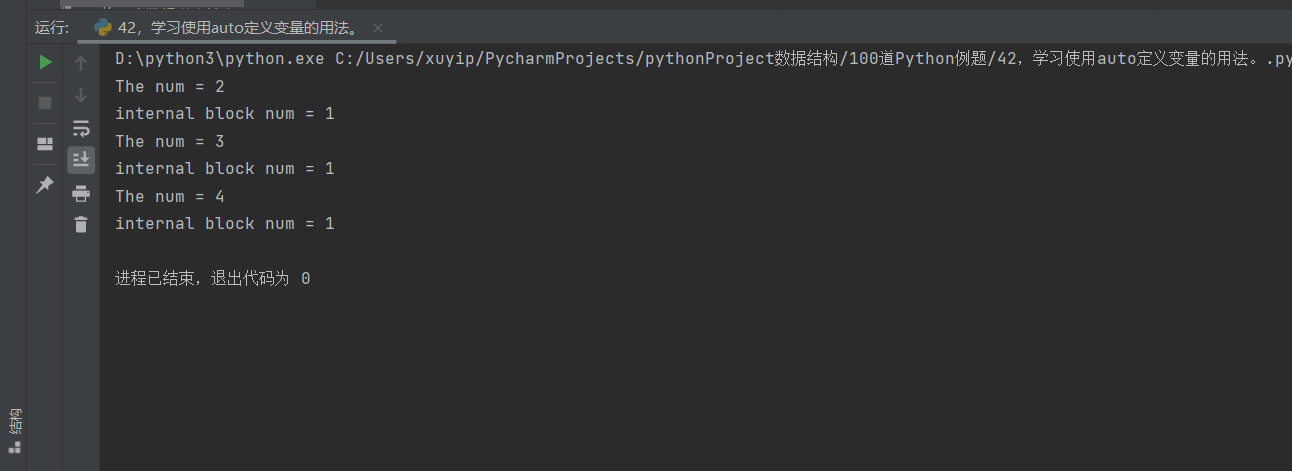
📢📢📢📣📣📣
🌻🌻🌻 Hello, everyone. My name is Dream. I'm an interesting Python blogger. I have a small white one. Please take care of it 😜😜😜
🏅🏅🏅 CSDN is a new star creator in Python field and is a sophomore. Welcome to find me for cooperative learning (VX wants to enter the learning exchange group or learning materials at the end of the article. Welcome + + +)
💕 Introduction note: this paradise is never short of genius, and hard work is your final admission ticket! 🚀🚀🚀
💓 Finally, may we all shine where we can't see and make progress together 🍺🍺🍺
🍉🍉🍉 "Ten thousand times sad, there will still be Dream, I have been waiting for you in the warmest place", singing is me! Ha ha ha~ 🌈🌈🌈
🌟🌟🌟✨✨✨
Here is a record of my mental process of brushing 100 questions. I send an article every 10 questions. I hope you can learn from it and stick to it! Welcome to supervise and study together!
Question 41
1. Title
41. Imitate the usage of static variables.
2. Code
# -*-coding:utf-8 -*-
# @Author: it's time. I love brother Xu
# Ollie, do it!!!
# 41. Imitate the usage of static variables.
def varfunc():
var = 0
print ('var = %d' % var)
var += 1
if __name__ == '__main__':
for i in range(3):
varfunc()
# Properties of class
# As an attribute of the class
class Static:
StaticVar = 5
def varfunc(self):
self.StaticVar += 1
print (self.StaticVar)
print(Static.StaticVar)
a = Static()
for i in range(3):
a.varfunc()
3. Ideas
Static method call and implementation!
Question 42
1. Title
42. Learn how to use auto to define variables.
2. Code
# 42. Learn how to use auto to define variables.
num = 2
def autofunc():
num = 1
print ('internal block num = %d' % num)
num += 1
for i in range(3):
print ('The num = %d' % num)
num += 1
autofunc()
3. Ideas

Question 43
1. Title
43. Imitate another case of static.
2. Code
# -*-coding:utf-8 -*-
# @Author: it's time. I love brother Xu
# Ollie, do it!!!
class NUM:
num=1
def inc(self):
self.num+=1
print('num=%d'%self.num)
if __name__ =='__main__':
num = 2
inst = NUM()
for i in range(3):
num += 1
print('The num = %d'%num)
inst.inc()
3. Ideas

Question 44
1. Title
43. Two matrices with three rows and three columns, add the data at their corresponding positions, and return a new matrix:
2. Code
X = [[12, 7, 3],
[4, 5, 6],
[7, 8, 9]]
Y = [[5, 8, 1],
[6, 7, 3],
[4, 5,9]]
R = [[0,0,0],
[0,0,0],
[0,0,0]]
for i in range(len(X)):
for j in range(len(Y)):
R[i][j] = X[i][j]+Y[i][j]
print(R)
3. Ideas
Give two known matrices and add the elements in turn according to the position! 😇😇😇
Question 45
1. Title
45. Statistics are the sum of 1 to 100.
2. Code
# -*-coding:utf-8 -*-
# @Author: it's time. I love brother Xu
# Ollie, do it!!!
a=0
for i in range(101):
a+=i
print('The sum is %d'%a)
3. Ideas
That's it 😈😈😈
Question 46
1. Title
46. Find the square of the input number. If the square is less than 50, exit.
2. Code
# -*-coding:utf-8 -*-
# @Author: it's time. I love brother Xu
# Ollie, do it!!!
a = int(input('Please enter an integer:'))
aa = a**2
if aa >= 50:
print('{}The square of is{}'.format(a,aa))
else:
pass
3. Ideas
☀️☀️☀️ if determines the structure. if it is greater than, it will be output. if it is less than, it will end the process! ☀️☀️☀️
Question 47
1. Title
47. The two variable values are interchanged.
2. Code
# -*-coding:utf-8 -*-
# @Author: it's time. I love brother Xu
# Ollie, do it!!!
a = int(input("Please enter a Value of variable: "))
b = int(input("Please enter b Value of variable: "))
print ('x = %d,y = %d' % (a,b))
print ('x = %d,y = %d' % (b,a))
3. Ideas
Exchange is ok!
Question 48
1. Title
48. Comparison
2. Code
if __name__ == '__main__':
i = 10
j = 20
if i > j:
print ('%d greater than %d' % (i,j))
elif i == j:
print ('%d be equal to %d' % (i,j))
elif i < j:
print ('%d less than %d' % (i,j))
else:
print ('unknown')
3. Ideas
The comparison is over
Question 49
1. Title
48. Use lambda to create anonymous functions.
2. Code
S = lambda x,y:x+y print(S(2,8))
3. Ideas
lambda means anonymous function! lambda x, Y: a basic form of X + y
Question 50
1. Title
50. Output a random number.
2. Code
# -*-coding:utf-8 -*- # @Author: it's time. I love brother Xu # Ollie, do it!!! import random # Generate a random number between 10 and 20 print(random.uniform(10, 20))
3. Ideas
Random takes a random number.
print random.random() #Enter a random number between 0 and 1 print random.uniform(10,20) #Output random numbers between 10-20 print random.randint(10,20) #Output random integers between 10-20
[wonderful article] 💕 [recommended in previous periods]
Python 100 questions from "None" to "yes", daily supervision and clock in learning phase I: 1-10 questions, idea sharing + mental journey
Python 100 questions from "None" to "yes", daily supervision and clock in learning phase II: 11-20 questions, idea sharing + mental journey
Python 100 questions from "None" to "yes", daily supervision and clock in learning phase III: 21-30 questions, thinking sharing + mental journey
Python 100 questions from "None" to "yes", daily supervision and clock in learning phase IV: 31-40 questions, thinking sharing + mental journey
Conclusion: the fifth issue is completed successfully. See you in the sixth issue!!! Come on, stick to it!!!
🌲🌲🌲 Well, that's all I want to share with you today
❤️❤️❤️ If you like, don't save your one button three connections~

